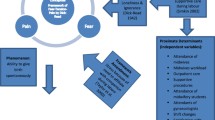Abstract
The aim of this study was to analyse the relationship between work in an operating room and pregnancy outcome, as described by the rates of spontaneous abortion and of birth defects. The population comprised the female nurses of 17 hospitals in Paris, interviewed in 1987–1989. An exposed group included all operating room nurses, and a control group was composed of female nurses in other departments matched by hospital, age and duration of service. Each woman described all prior pregnancies. In total, 776 pregnancies were described by 418 nurses who were first pregnant in 1970 or thereafter; ectopic pregnancies, those terminated by voluntary induced abortion and those leading to multiple births were excluded. The rate of spontaneous abortion was significantly higher for pregnancies during which women worked in an operating room than for the other pregnancies. Birth defects were not significantly related to work in an operating room during pregnancy. These results are in agreement with others showing a significant relationship between occupational exposure to operating rooms and spontaneous abortion, although identification of the responsible factor remains difficult. They suggest that effective ventilating systems should be installed in all operating rooms and that special preventive measures must be taken for women of childbearing age.
Similar content being viewed by others
References
Armstrong BG, McDonald A, Sloan M (1992) Cigarette, alcohol, and coffee consumption and spontaneous abortion. Am J Public Health 82:85–87
Axelsson G, Rylander R (1982) Exposure to anaesthetic gases and spontaneous abortion: response bias in a postal questionnaire study. Int J Epidemiol 11:250–256
Bonney GE (1987) Logistic regression for dependent binary observations. Biometrics 43:951–973
Bruce DL, Eide KA, Linde HW, Eckenhoff JE (1968) Causes of death among anesthesiologists: a 20-year study. Anesthesiology 29:565–569
Chang LW, Katz J (1976) Pathologic effects of chronic halothane inhalation: an overview. Anesthesiology 45:640–653
Cohen EN, Brown BW, Bruce DL, et al. (1974) Occupational disease among operating room personnel: a national study. Anesthesiology 41:321–340
Cohen EN, Brown BW, Wu ML, et al. (1980) Occupational disease in dentistry and chronic exposue to trace anesthetic gases. J Am Dent Assoc 101:21–31
Corbett TH, Cornell RG, Endres JL, Lieding K (1974) Birth defects among children of nurse-anesthetists. Anesthesiology 41:341–344
Dang Vu B, Estryn-Behar M, Monad G, Saint-Maurice Cl (1992) Theatre staff members and exposure to halogenated agents. Pediatr Anaesth 2:279–284
Ericson A, Källen B (1979) Survey of infants born in 1973 or 1975 to Swedish women working in operating rooms during their pregnancies. Anesth Analg 58:302–305
Gardner RJ (1989) Inhalation anaesthetics — exposure and control: a statistical comparison of personal exposures in operating theatres with and without anaesthetic gas scavenging. Ann Occup Hyg 33:159–173
Guirguis SS, Pelmear PL, Roy ML, Wong L (1990) Health effects associated with exposure to anaesthetic gases in Ontario hospital personnel. Br J Ind Med 47:490–497
Hemminki K, Axelson O, Niemi ML, Ahlborg G (1983) Assessment of methods and results of reproductive occupational epidemiology: spontaneous abortions and malformations in the offspring of working women. Am J Ind Med 4:293–307
Hemminki K, Kyyrönen P, Lindbohm ML (1985) Spontaneous abortions and malformations in the offspring of nurses exposed to anaesthetic gases, cytostatic drugs, and other potential hazards in hospitals, based on registered information of outcome. J Epidemiol Community Health 39:141–147
Hemminki K, Hemminki E, Lindbohm ML, Taskinen H (1990) Exogenous causes of spontaneous abortion. In: Huisjes H, Lind T (eds) Early pregnancy failure. Churchill Livingstone, London
Knill-Jones RP, Rodrigues LV, Moir DD, Spence AA (1972) Anaesthetic practice and pregnancy: controlled survey of women anaesthetists in the United Kingdom. Lancet 1:1326–1328
Lauwerys R, Siddons M, Misson CB, et al. (1981) Anaesthetic health hazards among Belgian nurses and physicians. Int Arch Occup Environ Health 48:195–203
McDonald A, McDonald JC, Armstrong B, Cherry NM, Côté R, Lavoie J, Nolin AD, Robert D (1988) Congential defects and work in pregnancy. Br J Ind Med 45:581–588
Pharoah POD, Alberman E, Doyle P, Chamberlain G (1977) Outcome of pregnancy among women in anaesthetic practice. Lancet 1:34–36
Roman E (1984) Fetal loss rates and their relation to pregnancy order. J Epidemiol Commmunity Health 38:29–35
Saurel-Cubizolles MJ, Estryn-Behar M, Maillard MF, Mugnier N, Masson A, Monod G (1992) Neuropsychological symptoms and occupational exposure to anaesthetics. Br J Ind Med 49:276–281
Saurel-Cubizolles MJ, Estryn-Behar M, Maillard MF, Mugnier N, Monod G (1992) Working conditions for operating theatre staff. In: Estryn-Behar M, Gadbois C, Pottier M. Hospital ergonomics. Octares Editions, Toulouse, pp 209–214
Saurel-Cubizolles MJ, Job-Spira N, Estryn-Behar M (1993) Ectopic pregnancy and occupational exposure to antineoplastic drugs. Lancet 341:1169–1171
Selevan SG, Lindbohm ML, Hornung RW, Hemminki K (1985) A study of occupational exposure to antineoplastic drugs and fetal loss in nurses. N Engl J Med 313:1173–1178
Skov T, Maarup B, Olsen J, Rorth M, Winthereik H, Lynge E (1992) Leukaemia and reproductive outcome among nurses handling antineoplastic drugs. Br J Ind Med 49:855–861
Stücker I, Caillard JF, Collin R, Gout M, Poyen D, Hémon D (1990) Risk of spontaneous abortion among nurses handling antineoplastic drugs. Scand J Work Environ Health 16:102–107
Taskinen H, Lindbohm ML, Hemminki K (1986) Spontaneous abortions among women working in the pharmaceutical industry. Br J Ind Med 43:199–205
Wilcox AJ, Weinberg RC, Baird DD (1990) Risk factors for early pregnancy loss. Epidemiology 1:382–385
Author information
Authors and Affiliations
Rights and permissions
About this article
Cite this article
Saurel-Cubizolles, M.J., Hays, M. & Estryn-Behar, M. Work in operating rooms and pregnancy outcome among nurses. Int. Arch Occup Environ Heath 66, 235–241 (1994). https://doi.org/10.1007/BF00454361
Received:
Accepted:
Issue Date:
DOI: https://doi.org/10.1007/BF00454361



